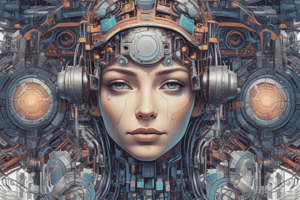Podcast
Questions and Answers
Machine learning models can learn from unlabeled data and identify patterns and relationships on their own.
Machine learning models can learn from unlabeled data and identify patterns and relationships on their own.
True (A)
Deep learning is a type of machine learning that uses labeled data and simple algorithms.
Deep learning is a type of machine learning that uses labeled data and simple algorithms.
False (B)
Machine learning models can make predictions and decisions based on their learning from data.
Machine learning models can make predictions and decisions based on their learning from data.
True (A)
A supervised machine learning model can be used to identify patterns in customer data and group similar customers together.
A supervised machine learning model can be used to identify patterns in customer data and group similar customers together.
Deep learning models are not suitable for tasks that require accurate identification of features, such as face recognition.
Deep learning models are not suitable for tasks that require accurate identification of features, such as face recognition.
Study Notes
Understanding Machine Learning in Artificial Intelligence
Machine learning is a subset of artificial intelligence (AI) that uses algorithms to analyze and learn from data, allowing computers to improve their performance without explicit programming. In simpler terms, it involves training a system on large amounts of data to recognize patterns and make predictions or decisions based on those patterns.
The primary goal of machine learning is to enable computers to learn from data and improve their performance on a specific task over time. This is achieved by providing the system with a dataset and using algorithms to learn from it. The algorithms identify patterns and features within the data, which can then be used to make predictions or decisions.
Machine learning is typically divided into two main categories:
Supervised Learning
Supervised learning involves using labeled data, where each data point is associated with a specific label or output. The system is trained on this data and learns to associate the input features with the correct output. This process enables the system to make predictions or decisions based on new, unseen data.
For example, consider a machine learning model trained to recognize images of dogs. The model would be provided with a dataset of images of dogs labeled as "dog" and other images labeled as "not a dog." The model would then learn to recognize features that are common to images of dogs, such as a snout, four legs, and fur, and use these features to identify dogs in new images.
Unsupervised Learning
Unsupervised learning, on the other hand, involves working with unlabeled data, where the system is left to identify patterns and relationships within the data on its own. This approach is often used for tasks where the desired outcome is not known in advance, such as grouping similar items together or identifying anomalies in the data.
For example, an unsupervised machine learning model might be used to analyze customer data and identify groups of customers with similar shopping behaviors. The model would look for patterns in the data, such as frequent purchases of specific products or spending habits, to group customers with similar behaviors together.
Deep Learning
Deep learning is a more advanced form of machine learning that uses neural networks to process and learn from data. Neural networks are designed to mimic the structure and function of the human brain, with layers of interconnected nodes that process information and learn from it.
Deep learning algorithms can handle complex data and are often used for tasks such as image or speech recognition, where the data is large and varied. For example, a deep learning model might be used to recognize faces in images, identifying features such as the shape of the eyes, nose, and mouth to accurately identify a face.
In summary, machine learning is a crucial aspect of artificial intelligence, allowing computers to learn from data and improve their performance on specific tasks. By using algorithms to analyze and learn from data, machine learning enables computers to make predictions, decisions, and even take actions based on that learning.
Studying That Suits You
Use AI to generate personalized quizzes and flashcards to suit your learning preferences.
Description
Discover the basics of machine learning, a subset of artificial intelligence that enables computers to learn from data and improve their performance on specific tasks. Learn about supervised, unsupervised, and deep learning, and how they are used to make predictions and decisions.




